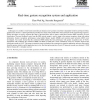700 search results - page 127 / 140 » Transducing Markov sequences |
RAS
2000
13 years 6 months ago
2000
Most of the current work on automated facial expression analysis attempt to recognize a small set of prototypic expressions, such as joy and fear. Such prototypic expressions, how...
IVC
2002
13 years 6 months ago
2002
In this paper, we consider a vision-based system that can interpret a user's gestures in real time to manipulate windows and objects within a graphical user interface. A hand...
JMLR
2002
13 years 6 months ago
2002
The temporal distance between events conveys information essential for numerous sequential tasks such as motor control and rhythm detection. While Hidden Markov Models tend to ign...
TASLP
2002
13 years 6 months ago
2002
In this paper, we propose a robust compensation strategy to deal effectively with extraneous acoustic variations for spontaneous speech recognition. This strategy extends speaker a...
JMLR
2010
13 years 5 months ago
2010
The problem of computing a maximum a posteriori (MAP) configuration is a central computational challenge associated with Markov random fields. There has been some focus on “tr...

